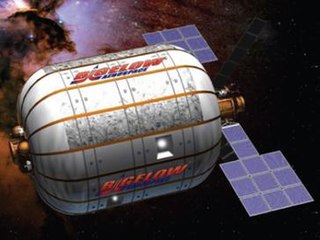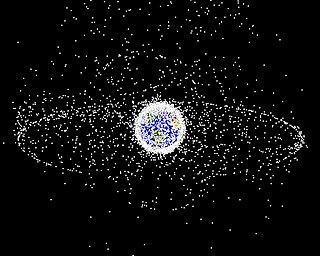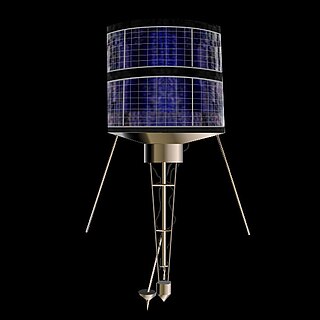Related Research Articles

Space debris are defunct human-made objects in space – principally in Earth orbit – which no longer serve a useful function. These include derelict spacecraft, mission-related debris, and particularly-numerous in-Earth orbit, fragmentation debris from the breakup of derelict rocket bodies and spacecraft. In addition to derelict human-made objects left in orbit, space debris includes fragments from disintegration, erosion, or collisions; solidified liquids expelled from spacecraft; unburned particles from solid rocket motors; and even paint flecks. Space debris represents a risk to spacecraft.

Kosmos 954 was a reconnaissance satellite launched by the Soviet Union in 1977. A malfunction prevented safe separation of its onboard nuclear reactor; when the satellite reentered the Earth's atmosphere the following year, it scattered radioactive debris over northern Canada, some of the debris landing in the Great Slave Lake next to Fort Resolution, NWT.

The Defense Meteorological Satellite Program (DMSP) monitors meteorological, oceanographic, and solar-terrestrial physics for the United States Department of Defense. The program is managed by the United States Space Force with on-orbit operations provided by the National Oceanic and Atmospheric Administration (NOAA). The mission of the satellites was revealed in March 1973. They provide cloud cover imagery from polar orbits that are Sun-synchronous at nominal altitude of 830 km (520 mi).
Bigelow Aerospace was an American space design and manufacturing company which closed its doors in 2020. It was an aeronautics and outer space technology company which manufactured and developed expandable space station modules. Bigelow Aerospace was founded by Robert Bigelow in 1998, and was based in North Las Vegas, Nevada. It was funded in large part by the profit Bigelow gained through his ownership of the hotel chain, Budget Suites of America.

The B330 was an inflatable space habitat privately developed by Bigelow Aerospace from 2010 until 2020. The design was evolved from NASA's TransHab habitat concept. B330 was to have 330 cubic meters (12,000 cu ft) of internal volume, hence its numeric designation.

The Kessler syndrome, proposed by NASA scientist Donald J. Kessler in 1978, is a scenario in which the density of objects in low Earth orbit (LEO) due to space pollution is numerous enough that collisions between objects could cause a cascade in which each collision generates space debris that increases the likelihood of further collisions. In 2009, Kessler wrote that modeling results had concluded that the debris environment was already unstable, "such that any attempt to achieve a growth-free small debris environment by eliminating sources of past debris will likely fail because fragments from future collisions will be generated faster than atmospheric drag will remove them". One implication is that the distribution of debris in orbit could render space activities and the use of satellites in specific orbital ranges difficult for many generations.

SpaceQuest, Ltd. is a spacecraft components and engineering company located in Fairfax, Virginia, which focuses on the operations of small satellites.

1971 saw the last three known deaths of cosmonauts of the Soviet space program and the only deaths in space. Their mission was to man humanity's first space station. The experimental bay door failed to separate so the first crew failed to dock and second crew were killed on re-entry. 1971 also saw the launch of the first and only British satellite on top of a British rocket after that success the program was cancelled.

The ASM-135 ASAT is an air-launched anti-satellite multistage missile that was developed by Ling-Temco-Vought's LTV Aerospace division. The ASM-135 was carried exclusively by United States Air Force (USAF) F-15 Eagle fighter aircraft.

Genesis II is the second experimental space habitat designed and built by the private American firm Bigelow Aerospace, launched in 2007. As the second module sent into orbit by the company, this spacecraft built on the data and experience gleaned from its previously orbited sister-ship Genesis I. Like its sister-ship and other modules being designed by Bigelow Aerospace, this spacecraft was based on the NASA TransHab design, which provided increased interior volume and reduced launch diameter along with potentially reduced mass compared to traditional rigid structures.

Kosmos-2251 was a Russian Strela-2M military communications satellite. It was launched into Low Earth orbit from Site 132/1 at the Plesetsk Cosmodrome at 04:17 UTC on 16 June 1993, by a Kosmos-3M carrier rocket.· The Strela satellites had a lifespan of 5 years, and the Russian government reported that Kosmos-2251 ceased functioning in 1995. Russia was later criticised by The Space Review for leaving a defunct satellite in a congested orbit, rather than deorbiting it. In response, Russia noted that they were not required to do so under international law. In any case, the KAUR-1 satellites had no propulsion system, which is usually required for deorbiting.

Iridium 33 was a communications satellite launched by Russia for Iridium Communications. It was launched into low Earth orbit from Site 81/23 at the Baikonur Cosmodrome at 01:36 UTC on 14 September 1997, by a Proton-K rocket with a Block DM2 upper stage. The launch was arranged by International Launch Services (ILS). It was operated in Plane 3 of the Iridium satellite constellation, with an ascending node of 230.9°.
Strictly speaking, a satellite collision is when two satellites collide while in orbit around a third, much larger body, such as a planet or moon. This definition is typically loosely extended to include collisions between sub-orbital or escape-velocity objects with an object in orbit. Prime examples are the anti-satellite weapon tests. There have been no observed collisions between natural satellites, but impact craters may show evidence of such events. Both intentional and unintentional collisions have occurred between man-made satellites around Earth since the 1980s. Anti-satellite weapon tests and failed rendezvous or docking operations can result in orbital space debris, which in turn may collide with other satellites.

On February 10, 2009, two communications satellites—the active commercial Iridium 33 and the derelict Russian military Kosmos 2251—accidentally collided at a speed of 11.7 km/s (26,000 mph) and an altitude of 789 kilometres (490 mi) above the Taymyr Peninsula in Siberia. It was the first time a hypervelocity collision occurred between two satellites; previous incidents had involved a satellite and a piece of space debris.
The passivation of a spacecraft is the removal of any internal energy contained in the vehicle at the end of its mission or useful life. Spent upper stages are generally passivated after their use as launch vehicles is complete, as are satellites when they can no longer be used for their design purpose.
Kosmos 2421 was a Russian spy satellite launched in 2006, but began fragmenting in early 2008. It also had the Konus-A science payload designed by Ioffe Institute to detect gamma-ray bursts. Three separate fragmentation events produced about 500 pieces of trackable debris. About half of those had already re-entered Earth's atmosphere by the fall of 2008.
Kosmos 1805 was a Soviet electronic intelligence satellite which was launched in 1986. The first of four Tselina-R satellites to fly, it was constructed by Yuzhnoye with its ELINT payload manufactured by TsNII-108 GKRE. Since it ceased operations it has remained in orbit as space junk, and in April 2012 NASA's Fermi Gamma-ray Space Telescope was forced to maneuver to avoid a collision with the derelict satellite.
The Gravity Gradient Stabilization Experiment (GGSE-4) was a technology satellite launched in 1967. This was ostensibly the fourth in a series that developed designs and deployment techniques later applied to the NOSS/Whitecloud reconnaissance satellites.

Kosmos-1408 was an electronic signals intelligence (ELINT) satellite operated by the Soviet Union. It was launched into low Earth orbit on 16 September 1982 at 14:55 UTC, replacing Kosmos-1378. It operated for around two years before becoming inactive and left in orbit.
References
- ↑ "COSMOS 1300". n2yo.com.
- ↑ "Tselina-D (11F619, Ikar)". Gunter's Space Page.
- ↑ "Bigelow Aerospace". Twitter. Retrieved 18 September 2019.
- ↑ Dvorsky, George (17 September 2019). "U.S. Air Force Warns There's a Chance an American and Russian Satellite Could Collide Overnight". Gizmodo. Retrieved 18 September 2019.
- ↑ Brockert, Ben. "wikkit". Twitter. Retrieved 18 September 2019.
- ↑ "Bigelow Aerospace". Twitter. Retrieved 18 September 2019.